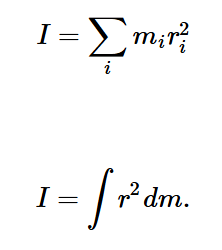SO29 Week 2 - Building planets from the inside out
1/45
There's no tags or description
Looks like no tags are added yet.
Name | Mastery | Learn | Test | Matching | Spaced |
|---|
No study sessions yet.
46 Terms
Why are planets/asteroids spherical?
Spherical objects will result when the force of the upper crust and mantle is large enough to deform the body. A sphere is then the lowest energy state shape in the absence of rotation
Pressure at the centre of a planet in hydrostatic equilibrium with constant density
dp =−gρdz
P_{c}=\frac{3GM^2}{8\pi R^4}
Need more data for more accurate models! This is a lower estimate of the internal pressure, as density usually increases with depth
Reason for the large magnetic fields of Jupiter and Saturn
At P > 1.4 Mbar, hydrogen behaves like a metal - fluidic metal hydrogen.
Magnetic fields of Neptune and Uranus
‘Ices’ would actually exist as a hot molecular fluid. These may be conducting, ionic fluids that support the generation of the planet’s magnetic fields
Ideal gas equation (and when it’s good)
pV = NkT. Ok for a giant planet’s atmosphere below about 50bar.
Maximum size of planet
Growth of a planets radius slows as more material is added and the existing material is compressed, making a maximum size that a sphere of matter can reach.
Measurement techniques for determining internal structure
Seismology, gravity mapping and heat flow experiments.
Seismology
Well known for planets with a solid surface, but concepts relating to oscillations of a body can also be applied to objects such as Jupiter and Saturn (and the Sun/stars). Needs new instrumentation though.
Gravity mapping
Measuring the gravitational field of a planet to determine how it deviates from a sphere or similar.
These can reveal details of crustal thickness
Very important for giant planets
The terrestrial planets are well approximated by spheres.
However, the the outer planets are essentially rapidly rotating balls of fluid and so they can distort and bulge out in response to the centrifugal force - gravitational distorted.
Heat flow experiments
Probes dug into the surface at about 2m that accurately record temp at depth. Also observations of thermal emission to space from e.g. a giant planet atmosphere
Longitude and lattitude
• Latitude is centred on the equator and goes from +/- 90 degrees at the poles
• Longitude is defined with respect to fixed position on a surface, e.g. Greenwich for the Earth.
• For planets without a surface, longitude is often defined with respect to e.g. the magnetic field etc.
• All this assumes that the planet is, broadly speaking, spherical of course.
• This has implications for oblate planets such as Jupiter and Saturn…
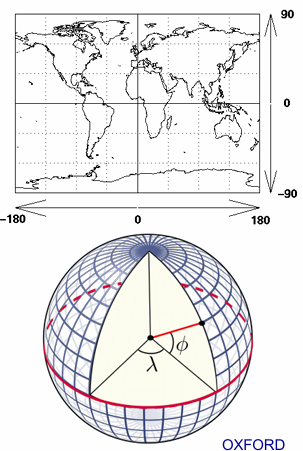
Planetocentric and planetographic latitude.
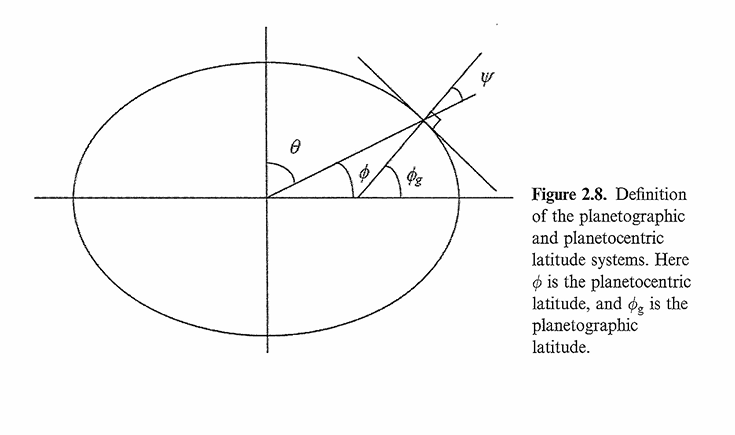
Measuring polar moment of inertia C
For e.g. Mars used a very stable frequency radio transmitter to study the slight changes in Doppler frequency.
For a giant planet, the values of C can’t be measured directly, but can be inferred by: Knowledge of the mass of the planet M. Its equatorial radius Re, Its sidereal rotation period T and the J2 coefficient
Moment of inertia ratio
\frac{C}{MR_{e}^{2}} provides info on the degree of mass concentration to the centre.
For a hollow sphere = 2/3.
For a sphere with uniform density = 0.4
For a sphere with all the mass at the centre = 0
Energy balance for giant planet interiors (skip —> think it would be given)

Putting these terms together gives the gain in energy at a planet’s surface for over a time dt for a layer dR, where T0 is the initial temperature of the accreting material.
If dR/dt is rapid then much of the heat is ‘buried’ during formation, as more material is added before the excess heat is radiated to space - evidence for a rapid formation of giant planets.
Radiative equilibrium temperature.
Applying the Stefan-Boltzmann law we obtain for the total radiant power of the Sun: P_{sun}=4\pi\sigma R_{sun}^2T_{sun}^4 (W).
The solar constant S is then given by: S=\sigma T_{sun}^4\left(\frac{R_{sun}}{D_{sun}}\right)^2 where D_{sun} is the planet’s distance to the Sun in AU.
For equilibrium P_{planet}=4\pi\sigma R_{planet}^2T_{eq}^4=(1-A)S\pi R_{planet}^2 (W), where the radiative equilibrium temperature is T_{eq} and the bond albedo is A
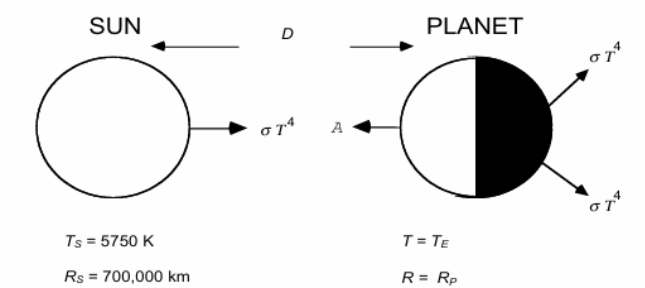
Giant planet thermal emission
The intrinsic (Li) of a planet is given by the difference between the equilibrium temperature (T_E) and the measured emission temperature (T_{emit}).
L_{i}=4\pi R^2\sigma(T_{emit}^4-T_{E}^4)
If the internal heat flux is due solely to the emission of energy stored during accretion then we can use this to estimate the rate of change of the internal temperature:
\frac{dT_{i}}{dt}=\frac{L}{c_{v}M}
Here Ti is the intrinsic temperature, cv is the specific heat at constant volume and M is the mass of the planet.
Mechanisms of internal heat for terrestrial planets
Radioactive decay
Why is the temperature of Saturn lower than expected
Implies that H and He are slightly immiscible - He can precipitate out in the metallic hydrogen envelope of Jupiter and especially Saturn.
Structure of Jupiter and Saturn
Although Juno mission suggests diluted core for Jupiter (possibly due to a giant impact early in Jupiter’s formation)
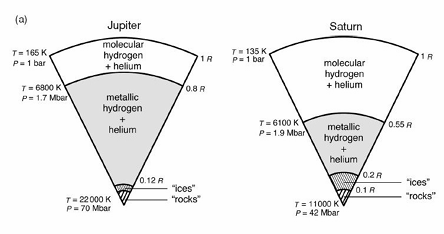
Constraints on the internal structures of Jupiter and Saturn
Mass, radius, rotation period, oblateness, internal heat source and J-coefficients.
Interior of Uranus and Neptune
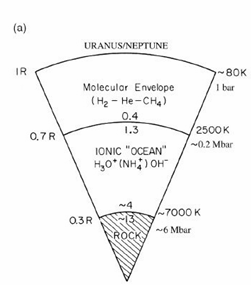
What causes seismic waves?
quakes (Mars/Earth/Moon etc), meteorite impacts, volcanic activity or human induced explosions
Body waves
seismic waves which travel through the body of a planet. They are reflected and transmitted at interfaces where the seismic velocity or density changes.They obey Snell’s law at these boundaries.
P waves
Primary / pressure / push-pull. Involve compression and rarefaction of the material as the wave passes it through it but NO rotation. Dilatational or irrotational waves.
S waves
Secondary / shear / shake. Involve shearing and rotation of the material as the wave passes through it, but not volume change. Rotational or equivoluminal waves. S waves can be polarised into SV(ertical) and SH(orizontal) waves.
Which waves arrive first?
P always before S
Stress
Units of force per unit area (Pa or bar). Normal stress perpendicular to the surface, shearing stress tangential to area.
Cubical dilation

Young’s modulus

Bulk modulus (define)

S waves in a liquid
Cannot travel into a liquid! But can reflect and/or convert to P-waves at a liquid boundary
Velocity of P wave

Velocity of S wave

Surface waves.
Surface waves have larger amplitudes and longer duration than body waves. They have lower velocities and so arrive after the body waves
Love waves
entirely horizontal, but transverse to the propagation of the waves
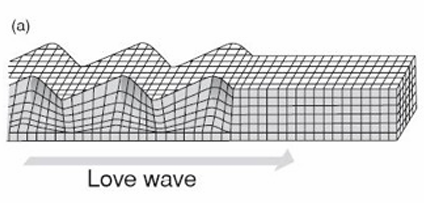
Rayleigh waves
the particle motion is a vertical ellipse, so the motion is described as a ‘ground roll’
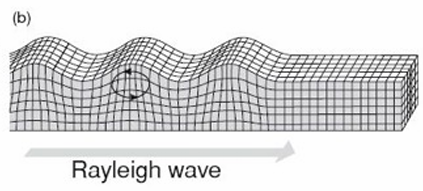
Seismogram
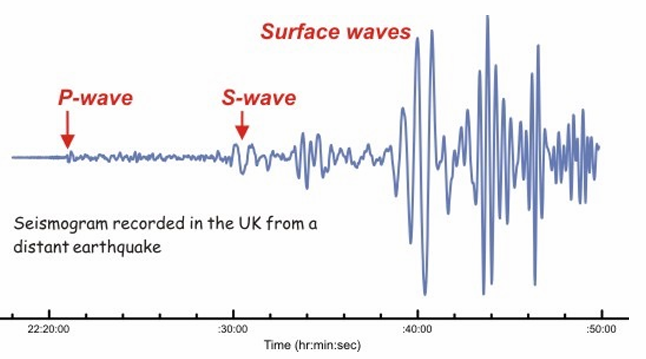
Definition of bulk modulus
K_{m}=\rho\left(\frac{\partial P}{\partial\rho}\right)_{S}
If the planet’s interior is adiabatic and chemically homogeneous, the bulk modulus of the material becomes
K_{m}\thickapprox\rho\frac{dp}{d\rho}
\frac{K_{m}}{\rho}=v_{P}^2-\frac43v_{S}^2
Internal structure of Earth determined by seismic measurements

Assumptions with models of seismic waves
Temperature gradient is adiabatic. But there is convection in the mantle e.g. plate tectonics, Rayleigh-Benard convection etc. Also likely motion in the liquid core to generate a magnetic field. Equation can be modified to include a non-adiabatic temperature gradient.
No chemical or phase change, other than already accounted for by changes at boundaries, e.g. crust, mantle and core can have different compositions between each other but not internally – mantle ‘rock’ is always mantle ‘rock’ independent of pressure.
Phase change can mean a change in crystalline structure, and high pressure lab experiments show that this can occur at mantle Ts and Ps.
In the mantle transition zone (400 – 1000 km) depth there are jumps in the seismic velocity that may be due to changes in silicate minerals.
Moonquakes.
Compared to the Earth where quakes can occur near the surface (faults etc) Moonquakes can be deep ( down to ~ 1000 km) and shallow from numerous meteorite (or rocket!) impacts.
Deep Moonquakes ( 700 -1000 km depth) are correlated with the tides raised by the Earth.
Note that all stations were on the near side, leading core seismic studies almost impossible.
Surface quakes can also be triggered by thermal shock due to sudden increase in temperature after the two week long lunar night ends (temps ~ 100 K at night)
Compared to Earth, seismic data show intense scattering and reverberation in the crust.
Very long reverberations and coda for the P and S waves.
Lunar free oscillations require a long time to damp, implying a very dry Moon, depleted in volatiles
Venus internal structure
Venus has no magnetic field. Surface looks young and little evidence for plate tectonics.
Venus is less dense than Earth
this might imply that internal dynamics never allowed a dynamo to start, so liquid core but no convection.
Or a lack of sulphur in the region of the solar nebula where Venus formed prevents Iron Sulphide forming that reduces the melting point of iron on Earth, so frozen core.
Tracking measurements (gravity mapping) of Venus orbiters suggest a liquid core, but more data is badly needed
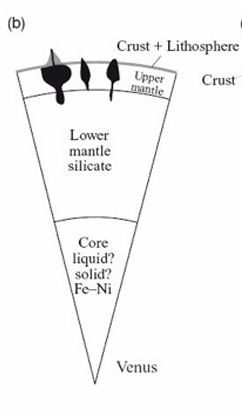
Effect of dust in Mars’ atmosphere
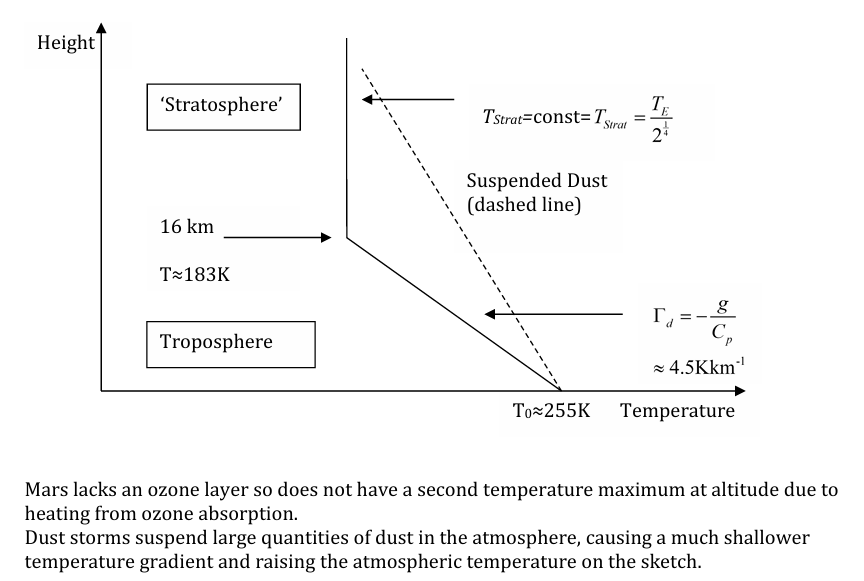
Stephan-Boltzmann equation
F = εσT4 , F = total flux, ε = effective emissivity (a value between 0 and 1), σ is a constant and T = temperature in Kelvin.
P = AεσT4
Moment of inertia definition
